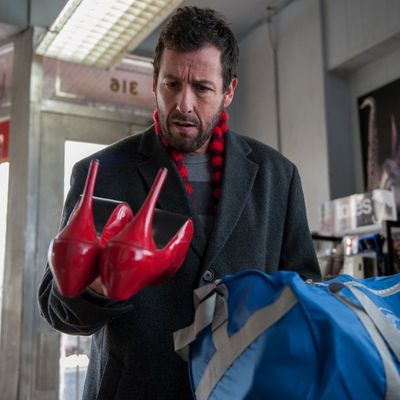
I so, so wanted The Cobbler to be good. Adam Sandler has been on a disappointing streak of late — to put it mildly — and director Tom McCarthy seemed like someone who could help turn things around. The filmmaker specializes in mild-mannered, often charming indie comedy-dramas (The Station Agent, The Visitor, Win-Win); his work doesn’t set the world on fire, but it’s clear he brings great care and sensitivity to it. Maybe, I thought, he could help Sandler connect to something other than shtick, or keep him from sleepwalking through another paycheck. Well, I was wrong. Or, actually, half-right, but still mostly wrong. Throughout The Cobbler, Sandler himself seems more invested than he’s been for a long time. But the rest of this ghastly movie lets him down.
The idea, in its broad strokes, is promising: Sandler plays Max Simkin, a Lower East Side cobbler who discovers the ability to transform into another person when he puts on their shoes. His power comes from a stitching machine that’s been in his family for years, which he discovers when his regular one goes bust. The store has been passed down through generations, but now, a developer is threatening the entire neighborhood. A lovely young community activist, Carmen (Melonie Diaz), comes by trying to enlist Max’s help in fighting back against the deal, but our hero is pretty disaffected with life; he’s not so averse to selling the store for a ton of money and moving away. He doesn’t like dealing with customers, anyway, or with people of any sort.
But we know that once he walks a mile in their shoes (literally), all that will change. And The Cobbler seems to have its heart in the right place – using Max’s power to try to restitch him (and, by extension, all us poor alienated schlubs in the audience) back to the city and the world he lives in, to open his eyes to the variety of life and experience around him. That’s the idea, anyway, but The Cobbler offers up a clinic in how not to tell a story. Repeatedly, McCarthy focuses on the least interesting, most inane aspects of the material. The film winds up only paying lip service to the walk-a-mile-in-another-person’s shoes idea, with a couple of quick, tepid montages (at one point, Max walks through Chinatown as an Asian man and marvels triumphantly at his Chinese accent). Similarly, a subplot about Max’s vanished father, whom he impersonates at one point for his poor, sick mother’s sake (surprise, dad’s played by Dustin Hoffman!), gets short-shrifted, despite being the only element in the film with any kind of emotional valence.
Instead, McCarthy is more interested in a fairly dumb crime-caper story line involving a local hoodlum (Method Man) whom Max impersonates, a subplot that is not only thoroughly uninteresting but also manages to be vaguely offensive. And should we make something of the fact that whenever he commits a crime in one of his other guises — robbing a rich man’s shoes, skipping out on a restaurant bill — Max always seems to be black? Is it a comment on something, or just an unfortunate narrative coincidence? It’s hard to tell, because the film doesn’t seem very self-aware. Which is odd, because once upon a time, Sandler was all about self-awareness.
How in hell did this happen? The haphazard storytelling and tonal mishmash of The Cobbler seem beneath McCarthy. At times, one wonders if maybe the film originated as something more high-concept. You can sort of imagine this as one of Sandler’s big-ticket Happy Madison productions, maybe complete with unfortunate makeup effects and a troubling Rob Schneider cameo. In its current form, the film doesn’t ask Sandler to play the various personae that Max inhabits; this is understandable, but it also has the side effect of leaving Sandler a bystander in his own movie. That puts the onus on the rest of the cast – but they spend most of their time looking bewildered and strangely out of it. That means that for much of the film’s running time, we’re watching people be consciously inept and distanced. It feels like an experiment, not a movie.
Or maybe it’s simpler than that, having to do with the fact that McCarthy and Sandler’s sensibilities may just have been too different. Maybe The Cobbler was supposed to be something more dramatic and emotional but wound up getting neutered when a top-flight comedian became involved. Who knows? Besides, it’s not for us to figure out the details of where this production went wrong. All we can do is watch the finished film, marvel at the wreckage, and lament the talent involved.


